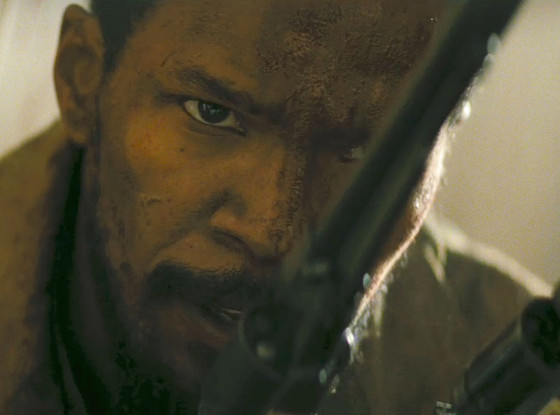I tend to see movies or read something, and I don’t want to write about it immediately. I like to let it settle a bit, mull it over, slow cook it. Django Unchained is the latest to get that treatment. And I’m glad I was patient.
Because I don’t love Django. That’s a pretty big deal for me. Right now there are only two directors who – no matter what the title, genre, stars, reviews, etc. – automatically move me to pay theater prices. One is Christopher Nolan. The other is Quentin Tarantino.
Prior to this, the only Tarantino I’d say I didn’t really get into was the second Kill Bill. Reservoir Dogs, Pulp Fiction, Jackie Brown, Death Proof, Kill Bill the first, Inglorious Basterds (as well as the episodes of ER and CSI that he was behind). Even movies he’s written but not directed: From Dusk ‘Til Dawn, True Romance, Natural Born Killers. I love what Quentin does with language and his ability to re-imagine B-movie trash as arthouse fare. He’s earned my loyalty.
And Django does have a lot to love. The scene where Dr. King Schultz (Christoph Waltz, who I’d love to see as a Bond villain some day) and Django (Jamie Foxx), a freed slave, go out to meet the marshal and his deputized townspeople after Schultz has killed the town sheriff is masterful. Schultz’s running monologue is humorous and telling of what to expect from the dentist-turned-bounty hunter. Django’s reaction to a white man chasing away another white man so he can have a drink with a black man is hilarious. And the Tom Wopat cameo, classic Tarantino. The building of tension as Schultz states his case and turns the situation around on the townsfolk is the sort of thing Tarantino does best, and is why he received such acclaim for Inglorious Basterds.
The problem is that Django is at least 20 minutes too long. The scenes where Django helps Schultz find and kill a trio of brothers for the bounty is unnecessary. We don’t learn anything about Schultz or Django, and when Schultz confronts the plantation owner and his crew about the bounties, it’s a watered-down version of what happened just minutes before in the scene I described in the last paragraph. Unlike the sneaky Wopat cameo, Don Johnson’s appearance as a slave-owning, Southern gentleman is so over the top I caught myself wondering if he was trying to channel Yosemite Sam. That incident could have been summed up in a couple of sentences, much like most of Django’s winter training was. It isn’t the only example of indulgence. Factor in the ripped-from-O-Brother-Where-Art-Thou? klan scene and Django’s escape from Australian slave traders, and you have a lot of fat. A leaner Django would have been a better Django.
I was also initially disappointed in what Tarantino had to say in Django. It has been said on several occasions that Bill Clinton was the first “black” president. Well, Tarantino is the first “black” arthouse director. From the not-so-good – his incessant use of the word “nigger” – to the good – the classic soul and hip-hop that dot the aural landscape of his films – Tarantino has always been fearless when it comes to adapting African-American culture to what he does.
So, naturally, in a film about slavery, I was ready for some real commentary from Tarantino about one of America’s darkest historical hours. He has deftly handled themes from the price of revenge (the Kill Bills) to just how important it is to choose the proper karmic path (Pulp Fiction). It was a big deal for me going in.
And then Tarantino … didn’t. I mean, I think it was an honest portrayal of just how disturbing slavery was, not just the enslavement but of the attitude actions of American caucasians toward blacks. But Quentin left it there. He presented it for the viewers to see and didn’t do anything to really put his stamp on it. It left me feeling a bit disappointed and empty.
But, well, that’s what the post-viewing cooling-off period is all about. The more I thought about Django, the more I realized Tarantino really did have something to say, it just wasn’t what I was hoping to hear. Django is a spaghetti western, set in the deep south during pre-Civil War America. But what it is about is the American attitude toward violence.
For example, the mandingo fighting scene where Django and the doc meet Calvin Candie (Leonardo DiCaprio). Yes, the fight between the two men is brutal, the desperation, fear and will to survive coming in waves off the two combatants. But it’s really no more brutal than, say, some of the rougher scenes from Fight Club. What is appalling is the attitude of everyone else in the room. Save Django and a couple of the slaves in the room, everyone else treats the bloody pummeling as if they were watching UFC on the big screen over the fireplace.
Extend that to the way being shot is portrayed through Django. Not much in the way of neat, clean holes except when tiny pistols are being used. Blood, tissue and bone explode, covering Django as he hides behind a dead body during a shootout. Every gunfight is brutal and incredibly destructive. Then you add in the beatings, the hot box, the near-neutering of Django, whipping and more. It’s all very naked and truthful.
For years, Quentin has been a target of the violence-in-media crowd. They say he’s made a living from glorifying violence. And I don’t know that he would argue against that. Few writers or directors understand exploitation better than he. However, in Django, Quentin chose the appropriate time and place in American history as a setting to get real. And for that, I think he should be applauded.
